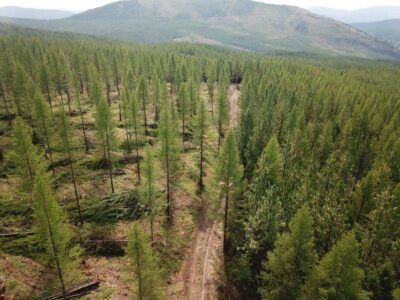Wishful thinking doesn’t justify grizzly delisting

Federal Judge Donald Molloy in Montana has ordered the Fish and Wildlife Service to restore grizzly bears in the Yellowstone area to the list of endangered and threatened species. Judge Molloy refused to allow FWS to delist the grizzly on the basis of unsupported wishful thinking about the bear’s future.
Grizzly bears once roamed across most of the North American west, but the population in Yellowstone is one of the few remaining remnants in the lower 48. The grizzly was listed as threatened under the Endangered Species Act in 1975, when there were about 1000 bears in the continental US, with an estimated 136 to 312 of those in the Greater Yellowstone Area.
In 2007, with the Yellowstone grizzly population up to about 500, FWS removed it from the protected list. The Greater Yellowstone Coalition Challenged that decision. This week, Judge Molloy ruled in their favor. He identified two major flaws with the delisting decision: a lack of enforceable regulatory mechanisms to assure protection of the population at adequate numbers into the future; and inadequate consideration of the impacts on the grizzly of whitebark pine declines.
The ESA requires the listing of species that are endangered or threatened due to habitat destruction; overutilization; disease or predation; “the inadequacy of existing regulatory mechanisms;” or other factors. 16 U.S.C. § 1533(a)(1). In order to remove a species from the list, FWS must conclude that the species no longer qualifies for listing on the basis of those same factors.
In most cases, the key question for delisting is whether legal protections post-listing will be sufficient to maintain the population at healthy levels. As Joel Pagel and I explained in Conservation Biology in 2001 (abstract here; pdf here for subscribers), delisting requires two distinct determinations: first, that the population has reached a biologically viable level; and second, that sufficient protections are in place to ensure maintenance of that population level.
With respect to the grizzly bear, the Greater Yellowstone Coalition challenged both findings. Judge Molloy rejected the claim that the population size was too small to support delisting, ruling that FWS had considered the best available science and that the evidence supported its conclusion that a population of 500 was sufficient. On the second finding, however, Judge Molloy delivered a sharp rebuke to the agency. He noted that the Conservation Strategy FWS had developed in conjunction with the states of Wyoming, Idaho, and Montana to guide grizzly management post-listing was not binding on its signatories. Instead of committing themselves to specific conservation actions, FWS admitted that the federal and state agencies had only “indicate[d] their intention to manage grizzly bears according to the Strategy.”
Even if it had been binding, the Conservation Strategy would not have satisfied legal requirements for delisting. Judge Molloy found that it was devoid of enforceable standards for important lands. Instead of specifying standards for permissible changes to habitat or limits on activities that lead to grizzly mortality, the Conservation Strategy simply promised that state and federal authorities would cooperate to develop future management goals and standards. Judge Molloy concluded that the management plans for the national forests in the region and the grizzly management plans drafted by the states suffered from the same fundamental flaw — none of them had sufficient enforceable standards to ensure grizzly protection.
In essence, Judge Molloy looked closely and found that the emperor had no clothes. There were lots of documents detailing how grizzly bears should be looked after following delisting, but no assurances other than promises and good intentions that those prescriptions would actually be followed.
Judge Molloy also faulted FWS for another kind of wishful thinking. Whitebark pine nuts are an important food source for Yellowstone grizzlies, but whitebark pines are declining in the region due to climate change and disease. In its delisting rule, FWS concluded that grizzly bears would not be threatened by the loss of whitebark pine because the bears would adapt to other food sources. Judge Molloy pointed out that there was little if any evidence to support that assumption. To the contrary, the evidence suggested that bears searching for food when pine nuts were not available were more likely to come into contact with people and to suffer human-caused mortality. That may already be happening — as Doug Peacock has pointed out in Yale Environment 360, grizzly bears were shot in record numbers in 2008.
It’s understandable that FWS and others who are deeply invested in conservation efforts want to celebrate their successes by delisting species which show population recoveries. But this decision should serve as a reminder that population increases by themselves don’t establish that delisting is appropriate. Delisting should happen only when the species’ future is secure, which means that the agency has taken a hard look at its future and verified that looming threats are adequately controlled. At that point, and only at that point, delisting can be cause for celebration rather than for litigation.
Reader Comments
2 Replies to “Wishful thinking doesn’t justify grizzly delisting”
Comments are closed.








Who could even begin to think FWS needs a population recovery to delist?
Below is the wording from the notice delisting Northern West Virginia Flying Squirrel in 2006 in which populations counts were never considered. Note the reference, also, to improvement and expansion of suitable habitat range, then the report that follows. FWS actually got this species delisted with a population of 1,200, and environmentalists there argued the agency actually counted them twice.
From the Record: “Habitat regeneration and recovery
actions have resulted in a reduction in the threats, which has led to:
(1) A significant increase in the number of known WVNFS captures and
distinct capture locations; (2) verification of multiple-generation
reproduction and persistence throughout the range; (3) proven WVNFS
resiliency; and (4) substantial improvement and continued expansion of suitable habitat rangewide.”
From a US Forest Service/W.Va. Dept. of Forestry paper also released in 2006: “Abstract The Virginia northern flying squirrel Glaucomys
sabrinus fuscus is a Vulnerable sciurid that has
experienced a 90% reduction of suitable high elevation
boreal montane forest habitat over the last century in the
central Appalachians of West Virginia and Virginia,
USA.”
So FWS has apparently not heard of mountaintop removal or Mead paper company.
Another Note: FWS is preparing to propose delisting the Indiana Bat, also, even though its count is half of what it was when originally listed as one of the first three species covered under the act in 1967-68. It’s recovery plan has not even been updated for nearly 30 years….FOIA’d documents prove the National Mining Association received drafts of a new recovery plan in 2007 prior to public availability and was permitted to negotiate content with FWS, prior to public commnet.
These are two in just my backyard….
Its terrible that people are still hunting bears.